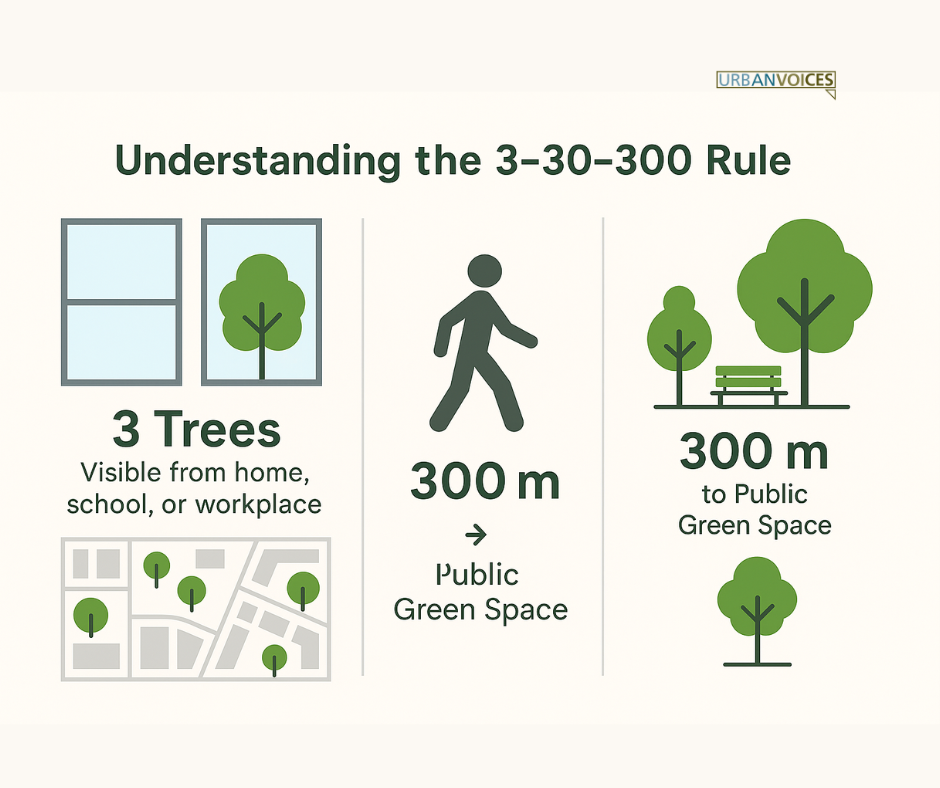3 trees, 30% canopy, 300m to a park: the rule every city needs

Why Green Spaces in Cities Matter More Than Ever. Ever looked out your window and seen nothing green? Just concrete, wires, and walls? You’re not alone. And that absence isn’t just an eyesore – it’s a public health warning. In 2021, urban forestry expert Cecil Konijnendijk introduced the 3–30–300 rule – a simple, research-backed formula for creating healthier, greener, and more liveable cities:
- 3 trees visible from your home, school, or workplace
- 30% tree canopy cover in every neighbourhood
- 300 metres to the nearest public green space
This tree canopy rule is gaining traction among city planners and public health experts. For Indian cities facing rising temperatures, air pollution, and overcrowding, it’s not optional – it’s urgent.
The beauty of the rule; it’s communicable, measurable, and scalable.
The Rule Is Not Just Aesthetic. It’s Functional
The 3–30–300 rule wasn’t dreamed up in a planner’s office. It was built on decades of global research on urban nature, public health, and climate resilience. Here’s why it matters:
Tree visibility (the 3): Just being able to see trees from your window has been linked to lower stress, better focus, and faster recovery from illness (Velarde et al., 2007). Office workers perform better and report greater satisfaction when they can see greenery (Lottrup et al., 2013).
Tree canopy cover (the 30): Neighbourhoods with at least 30% canopy are cooler, cleaner,and healthier. Trees cut down air pollution, moderate heat,and encourage walking and social interaction(Astell-Burt & Feng, 2020).
Proximity to parks (the 300): Having a green space within a 5-minute walk boosts mental and physical well-being. It increases usage, especially for vulnerable groups like the elderly or children (World Health Organisation)
Benefits of Urban Greenery: Why the 3–30–300 Rule Works
This isn’t just about beautification. Urban greenery improves air quality, reduces heat, boosts mental health, and promotes physical activity. Let’s break down why this rule matters:
1. Trees help us breathe and beat the heat
Urban heat islands are a serious problem in Indian cities. Trees provide shade and release moisture through evapotranspiration, reducing local temperatures by up to 4-5°C. A 2023 European Environment Agency report, citing a study in Nature Medicine, found that increasing tree coverage to 30% in European cities could reduce temperatures and prevent nearly 40% of deaths linked to the urban heat island effect.
2. Trees clean the air and protect our lungs
Air pollution in cities such as Delhi, Mumbai, and Kolkata frequently exceeds safe levels. Trees absorb harmful gases like nitrogen dioxide and trap dust particles. The study “Multiple health benefits of urban tree canopy: The mounting evidence for a green prescription” found “an important role for trees and nature in improving human health at the community scale in urban areas.”
3. Green views reduce stress and improve mental health
Just being able to see trees from your window reduces anxiety, boosts concentration, and improves overall well-being. A study published in Urban Forestry & Urban Greening links visual access to greenery with lower stress levels.
4. Access to parks promotes physical and mental well-being
Living within 300 metres of a public park makes people more likely to exercise and interact socially. This is especially critical for children, the elderly, and low-income families who may lack access to private outdoor spaces.
Nagpur’s Green Gap: What the Data Reveals
Despite its reputation as a green city, a recent study applied the 3–30–300 rule in Nagpur, a city often lauded for its urban greenery (Lahoti et al., 2025). But once you zoom into the neighbourhood level, the story changes.
Key Findings :
- More than 80% of residents lacked access to a public park within 300 metres.
- The researchers developed an Urban Greenness Exposure Index (UGEI) to combine visibility, canopy, and access into a single, zone-level score. It revealed massive intra-city disparities even in areas considered “green” on paper.
- This data busts a myth: planting trees is not enough. What matters is where they are, who can see them, and how easily they can be accessed.
- In low-greenness zones, nearly 25% of residents couldn’t see even two trees from their home. Canopy cover was as low as 7%, far from the 30% benchmark.
This data busts a myth: planting trees is not enough. What matters is where they are, who can see
them, and how easily they can be accessed.
The Way Forward for Greener Indian Cities
1. Make 3–30–300 part of urban development policies
Cities must integrate green visibility into building regulations. Tree canopy targets should apply at the neighbourhood level. Micro-parks should be mandatory within a 5-minute walking radius from every residence.
2. Use data tools to prioritise tree planting
Cities can adopt the Urban Greenness Exposure Index (UGEI) to map areas with low tree cover, poor visibility, and limited access. This ensures tree planting efforts focus on the most underserved communities.
3. Align with national green missions
The 3–30–300 rule should be embedded into Smart Cities, AMRUT 2.0, and NCAP goals. CSR initiatives can be directed towards improving real-time greenery, not symbolic tree drives.
4. Get creative in space-crunched cities
In dense metros, vertical gardens, treed streets, rooftop green spaces, and green facades can substitute for traditional parks. Innovation can bring nature into the heart of concrete jungles.
Why Urban Tree Visibility is More Than a View
The beauty of the 3-30–300 rule is its human focus. It doesn’t ask, “How many trees were planted?” It asks, “Can a child see a tree? Can her grandmother reach a shaded bench?”
In the battle against urban heat, pollution, and mental burnout, this is the green strategy India’s cities need.
